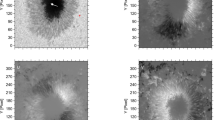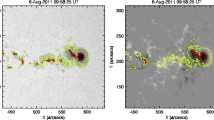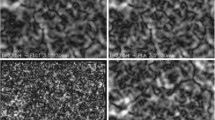Abstract
We aim to study the physical nature of a central umbral dot (UD) close to disk center by analyzing full-Stokes spectra of the two Fe i lines at 630 nm recorded by the spectropolarimeter on Hinode. Thermal and magnetic properties of the UD were directly inferred from Stokes profiles. Then, we applied the inversion code SIR to retrieve a single-component magnetic model atmosphere that recovers the observed full-Stokes profiles. The inversion results and direct inferences from the iron line pair are consistent. The studied UD does not show any signatures of upflows, but tends to show downflows. At the deeper-half of the photosphere (logτ>−1.0), the UD exhibits rapid changes in temperature with respect to its surroundings. The UD has a large magnetic field strength of about 3000 G without significant reduction at its center. Magnetic field lines are more vertical and twisted in the UD area than in the magnetic field of its surroundings. To explain the observational findings, we propose that the UD perturbs the funnel magnetic field of the umbra, making a tilt-ankle-knee configuration. A new interesting inference, deduced from the blending spectral lines in the observed wavelength interval, is that the shape and surface span of the UD in normalized intensity filtergrams computed at the core of the blending lines differ from the UD area seen in continuum intensity and in the filtergrams computed at the core of the iron line pair.
















Similar content being viewed by others
References
Allende Prieto, C., García López, R.J.: 1998, Astron. Astrophys. Suppl. Ser. 131, 431.
Bharti, L., Jain, R., Jaaffrey, S.N.A.: 2007, Astrophys. J. Lett. 665, 79L.
Bharti, L., Joshi, C., Jaaffrey, S.N.A.: 2007, Astrophys. J. Lett. 669, 57L.
Böhm-Vitense, E.: 1997, Introduction to Stellar Astrophysics 2, Cambridge Univ. Press, Cambridge.
Cabrera Solana, D., Bellot Rubio, L.R., del Toro Iniesta, J.C.: 2005, Solar Phys. 439, 687.
Choudhury, A.R.: 1986, Astrophys. J. 302, 809.
Collados, M., Martínez Pilet, V., Ruiz Cobo, B., del Toro Iniesta, J.C., Vázquez, M.: 1994, Astron. Astrophys. 291, 622.
Franz, M., Schlichenmaier, R.: 2009, Astron. Astrophys. 508, 1453.
Grec, C., Uitenbroek, H., Faurobert, M., Aime, C.: 2010, Astron. Astrophys. 514, 91.
Hamedivafa, H.: 2003, Astron. Astrophys. 407, 761.
Hamedivafa, H.: 2008, Solar Phys. 250, 17.
Hamedivafa, H.: 2011, Solar Phys. 270, 75.
Hamedivafa, H., Sobotka, M.: 2004, Astron. Astrophys. 428, 215.
Hartkorn, K., Rimmele, T.: 2003, ASP Conf. Ser. 286, 281.
Ishikawa, R., Tsuneta, S., Jurčák, J.: 2010, Astrophys. J. 713, 1310.
Khomenko, E., Collados, M.: 2007, Astrophys. J. 659, 1726.
Kilcik, A., Yurchyshyn, V.B., Rempel, M., Abramenko, V., Kitai, R., Goode, P.R., Watanabe, H.: 2012, Astrophys. J. 745, 163.
Kitai, R., Watanabe, H., Nakamura, T., Otsuji, K., Matsumoto, T., Ueno, S., et al.: 2007, Publ. Astron. Soc. Japan 59, 585.
Landi Degl’Innocenti, E.: 1992, In: F. Sanchez, M. Collados, M. Vázquez (eds.) Solar Observations: Techniques and Interpretation, Cambridge Univ. Press, Cambridge, 71.
Louis, R.E., Mathew, S.K., Bellot Rubio, L.R., Ichimoto, K., Ravindra, B., Raja Bayanna, A., et al.: 2012, Astrophys. J. 752, 109L.
Martínez González, M.J., Collados, M., Ruiz Cobo, B.: 2006, Astron. Astrophys. 456, 1159.
Moon, Y.-J., Kim, Y.-H., Park, Y.-D., Ichimoto, K., Sakurai, T., Chae, J., et al.: 2012, Publ. Astron. Soc. Japan 59, 625.
Moradi, H., Baldner, C., Birch, A.C., Braun, D.C., Cameron, R.H., Duvall, T.L. Jr., et al.: 2010, Solar Phys. 267, 1.
Nave, G., Johansson, S., Learner, R.C.M., Thorne, A.P., Brault, J.W.: 1994, Astrophys. J. Suppl. 94, 221.
Ortiz, A., Bellot Rubio, L.R., Rouppe van der Voort, L.: 2010, Astrophys. J. 713, 1282.
Parker, E.N.: 1979, Astrophys. J. 234, 333.
Rempel, M., Schlichenmaier, R.: 2011, Living Rev. Solar Phys. 8, 3.
Riethmüller, T.L., Solanki, S.K., Lagg, A.: 2008, Astrophys. J. Lett. 678, 157L.
Riethmüller, T.L., Solanki, S.K., Zakharov, V., Gandorfer, A.: 2008, Astron. Astrophys. 492, 233.
Rimmele, T.: 2004, Astrophys. J. 604, 906.
Rimmele, T.: 2008, Astrophys. J. 672, 684.
Ruiz Cobo, B., del Toro Iniesta, J.C.: 1992, Astrophys. J. 398, 375.
Schlichenmaier, R., Jahn, K., Schmidt, H.U.: 1998, Astrophys. J. Lett. 493, 121L.
Schüssler, M., Vögler, A.: 2006, Astrophys. J. Lett. 641, 73L.
Sobotka, M., Hanslmeier, A.: 2005, Astron. Astrophys. 442, 323.
Sobotka, M., Jurčák, J.: 2009, Astrophys. J. 694, 1080.
Sobotka, M., Puschmann, K.G.: 2009, Astron. Astrophys. 504, 575.
Sobotka, M., Bonet, J.A., Vázquez, M.: 1993, Astrophys. J. 415, 832.
Sobotka, M., Brandt, P.N., Simon, G.: 1997a, Astron. Astrophys. 328, 682.
Sobotka, M., Brandt, P.N., Simon, G.: 1997b, Astron. Astrophys. 328, 689.
Sobotka, M., Vázquez, M., Bonet, J.A., Hanslmeier, A., Hirzberger, J.: 1999, Astrophys. J. 511, 436.
Socas Navarro, H., Martínez Pilet, V., Sobotka, M., Vázquez, M.: 2004, Astrophys. J. 614, 448.
Solanki, S.K.: 1993, Space Sci. Rev. 63, 1.
Stenflo, J.O.: 2010, Astron. Astrophys. 517, 37.
Suematsu, Y., Tsuneta, S., Ichimoto, K., Shimizu, T., Otsubo, M., Katsukawa, Y., et al.: 2008, Solar Phys. 249, 197.
Thomas, J.H., Weiss, N.O.: 1992, In: J.H. Thomas, N.O. Weiss (eds.) Sunspots: Theory and Observations, Kluwer, Dordrecht, 3.
Thomas, J.H., Weiss, N.O.: 2004, Annu. Rev. Astron. Astrophys. 42, 517.
Tritschler, A., Schmidt, W.: 1997, Astron. Astrophys. 321, 643.
Tsuneta, S., Suematsu, Y., Ichimoto, K., Shimizu, T., Otsubo, M., Nagata, S., et al.: 2008, Solar Phys. 249, 167.
Watanabe, H., Kitai, R., Ichimoto, K.: 2009, Astrophys. J. 702, 1048.
Watanabe, H., Tritschler, A., Kitai, R., Ichimoto, K.: 2010, Solar Phys. 266, 5.
Watanabe, H., Bellot Rubio, L.R., de la Cruz Rodríguez, J., Rouppe van der Voort, L.: 2012, Astrophys. J. 757, 49.
Weiss, N.O., Proctor, M.R.E., Brownjohn, D.P.: 2002, Mon. Not. Roy. Astron. Soc. 337, 293.
Wiehr, E.: 1994, Astron. Astrophys. 287, 1L.
Acknowledgements
Hinode is a Japanese mission developed and launched by ISAS/JAXA, collaborating with NAOJ as a domestic partner, NASA and STFC (UK) as international partners. Scientific operation of the Hinode mission is conducted by the Hinode science team organized at ISAS/JAXA. This team mainly consists of scientists from institutes in the partner countries. Support for the post-launch operation is provided by JAXA and NAOJ (Japan), STFC (UK), NASA, ESA, and NSC (Norway). The author thanks NAOJ for hospitality during the Asian Solar Physics Winter School in 2008 sponsored by GUAS. The author would also like to thank Basilio Ruiz Cobo and Jan Jurčák for their help with SIR code, and the referee, who contributed useful suggestions for improving this article.
Author information
Authors and Affiliations
Corresponding author
Rights and permissions
About this article
Cite this article
Hamedivafa, H. Photospheric Stratification of a Central Umbral Dot Using Stokes Profiles Recorded by Hinode: A Different Single-Case Study. Sol Phys 286, 327–346 (2013). https://doi.org/10.1007/s11207-013-0277-9
Received:
Accepted:
Published:
Issue Date:
DOI: https://doi.org/10.1007/s11207-013-0277-9




